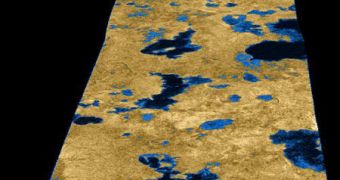For many years, astronomers have said that the primary goal of exploring space is discovering a habitable world. That's all well and good, until you stop to think about what the concept actually means. Over the decades, the definition has changed constantly, and experts say that it is most likely to continue doing so in the future as well. But one of the celestial bodies that is very likely to get included in a future definition, if it isn't already, is Saturn's frigid moon Titan, which a short while ago was far from anyone's idea of a habitable world, Space reports.
The standard definition of a habitable world is a planet or a moon located in the very narrow range of distances from its parent star that it supports liquid water on its surface. Many astronomers consider the presence of water as being as indispensable to the existence of life as sunlight itself. But how could Titan possibly meet this definition, when the water on its surface, if any, is trapped in rocks harder than granite? The gas giant's natural satellite features a surface temperature of around 94 degrees Kelvin (minus 179 degrees Celsius, or minus 290 degrees Fahrenheit), and still some astrobiologists believe that life there may have caught roots.
Their ideas are brought on by the fact that – while water is frozen solid – methane and ethane are not. These liquid hydrocarbons are believed to be forming numerous lakes, that dot the landscape on the satellite's north and south poles. In addition to the lakes themselves, measurements collected by the NASA Cassini spacecraft and the ESA Huygens lander have determined that the moon features a complete hydrocarbon cycle, in very much the same way Earth features a water cycle. In other words, the atmosphere on Titan rains down methane and ethane, but it is an atmosphere nonetheless. If life developed on a watery world, couldn't it develop on one made of hydrocarbons?
Another reason why experts get hope from the hydrocarbon cycle on the Saturnine moon is the fact that these chemicals can assemble themselves in complex molecules. Methane and ethane are of little use for life, but more advanced molecules form the basis of life here on Earth. Given that Titan has been around for a comparable amount of time as our planet, would it really be too much to hypothesize that its molecules evolved beyond the point of inanimate matter? But astrobiologists underline that DNA- and RNA-based life forms would be an impossibility there, as these molecules, which underlie life on Earth need oxygen and phosphorus, as well as water, in order to thrive.

 14 DAY TRIAL //
14 DAY TRIAL //